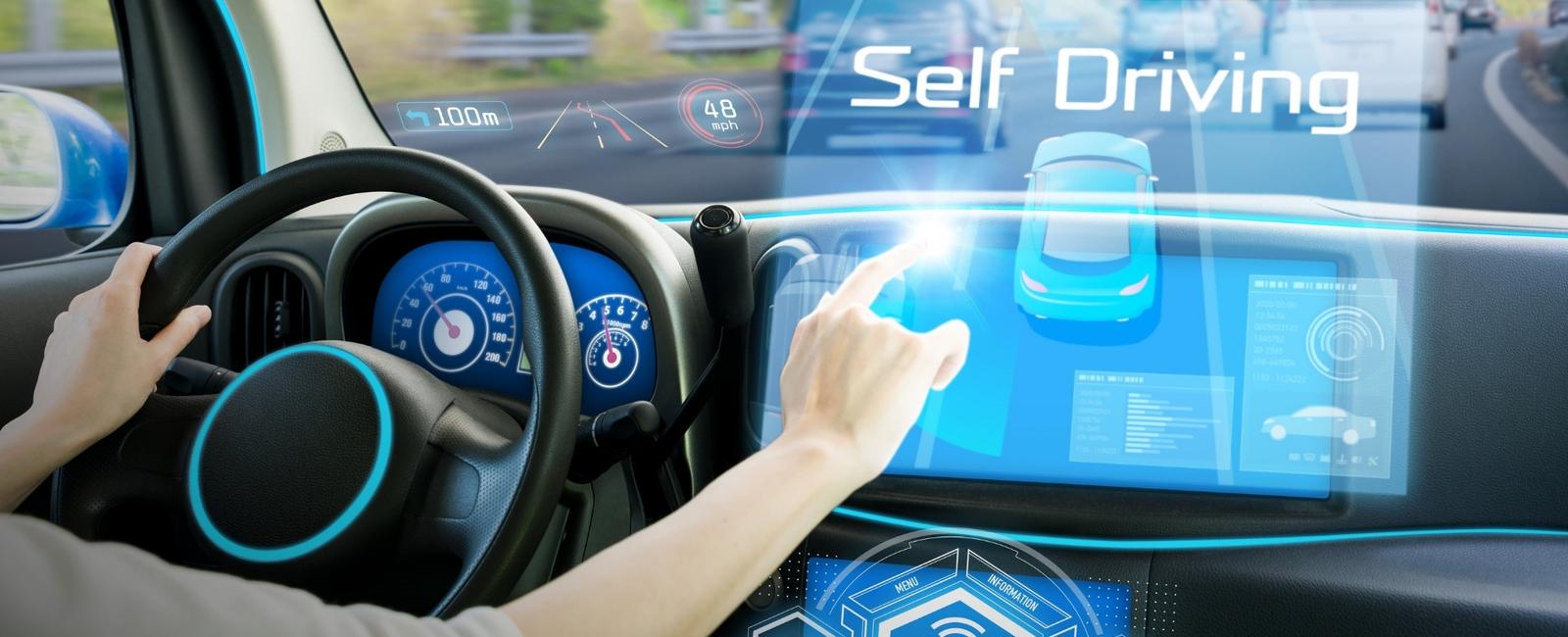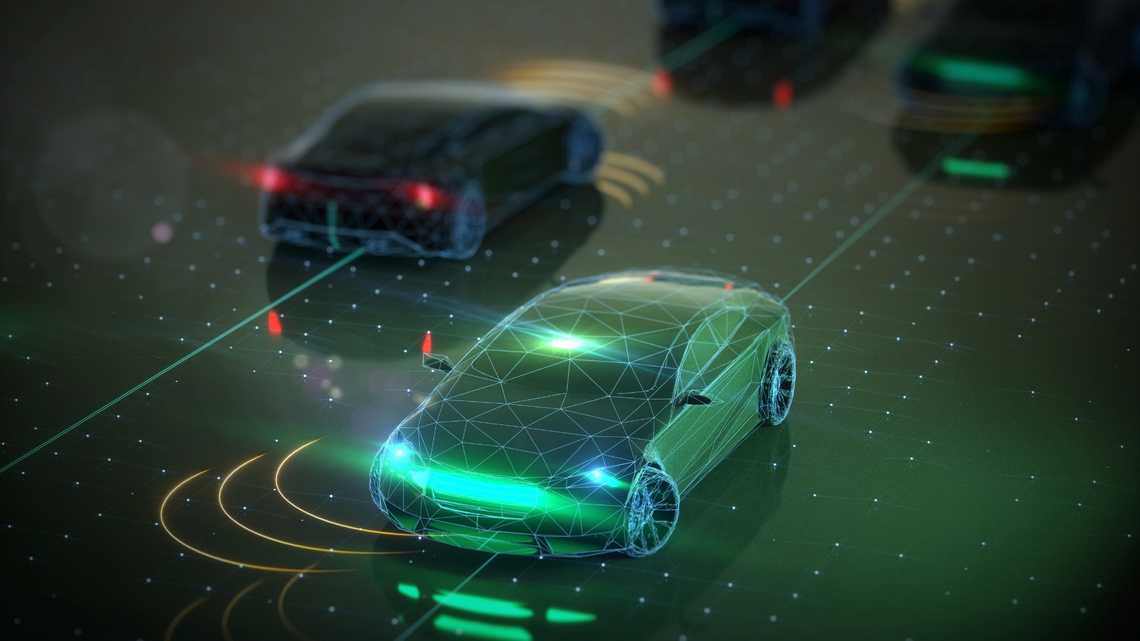AI's Impact on Autonomous Driving in 2024

In the automotive industry, AI leads to autonomous vehicle evolution. We enter the year 2024, and this blog discusses how AI influences self-driving vehicles. From enabling advanced driver-assistance systems (ADAS) to coordinating real-time decision-making, AI is the driving force propelling automotive technology’s revolutionary path. Read on to discover how AI is contributing to the future of autonomous driving.
The Evolution of Self-Driving Cars and the Role of AI
There is a close relationship between the development of self-driving cars and the AI evolution. In fact, AI is what made autonomous cars possible, as it gives them the ability to see their surroundings, make choices, and also navigate difficult situations. Here’s a brief overview of autonomous vehicle evolution and the role of AI
Pioneering Years and DARPA Challenges (2000s)
Self-driving cars began to take shape in the early 2000s due to innovative ideas and significant research efforts. One of the key milestones during this period was DARPA sponsoring challenges that promoted innovation in autonomous vehicle technology. AI became a key contributor, helping lay the groundwork for core elements like navigation and perception systems. Using early machine learning algorithms, players in these challenges utilized the data emerging from sensors and thus built a foundation for future developments.
Emergence of Commercial Players and Deep AI Integration (2010s)
The 2010s decade was a revolutionary change with the arrival of big players in self-driving. Firms like Google, Tesla, and traditional car-making behemoths took up the challenge of developing autonomous vehicles. The AI integration in this period was quite significant, with a focus on machine learning in self-driving cars and neural networks. AI technologies fused various systems used by autonomous vehicles that helped in enhancing the authenticity of such cars. Highly advanced AI algorithms were used in sensor fusion, object recognition, and decision-making tasks. This gave self-driving vehicles the capability to negotiate through increasingly dynamic situations while learning and adjusting from real road driving.
Deployment and Continuous Advancements (2018-onward)
In the last decade or so, self-driving cars have gone beyond being science projects and we can speak of a paradigm shift associated with widespread deployment. The introduction of commercial autonomous services by industry leaders such as Tesla has shown what the future could look like with AI-based navigational systems. As technology develops, so does the role of artificial intelligence in the automotive industry. Deep learning methods have become more common, helping self-driving systems understand complicated patterns and reach nuanced decisions. Second, advanced simulation environments have provided the means to conduct rigorous testing and result in the refinement of AI algorithms with controlled yet diverse settings. Further research into safety systems also confirms the commitment to ensuring the security and safety of self-driving technology.
The Role of Machine Learning in Navigation, Safety, and Dynamic Adaptation

With vehicles transforming into self-intelligent machines able to make sophisticated decisions, machine learning (ML) is essential for navigation, safety, and dynamical adaptation in diverse fields such as transportation, robotics, or smart systems. Here’s an overview of the role of ML in these domains:
Navigation
Machine learning algorithms transform navigation by analyzing huge quantities of information from sensors and mapping systems. With approaches such as supervised learning, autonomous cars learn how to read road layouts and traffic signs and determine optimal routes using historical data on traffic together with current conditions obtained directly from sensors. This adaptive navigation not only ensures an effective journey but also enables vehicles to react in different and changeable road conditions.
Safety
In the development of autonomous vehicles, passenger safety and those traveling on the road are key elements. It is machine learning, specifically in the sphere of computer vision, that allows cars to distinguish and respond to their environment. They rely on object detection algorithms such as those based on the use of convolutional neural networks, which detect pedestrians, vehicles, and obstacles, contributing to collision avoidance through overall road safety. In addition, machine learning-driven anomaly detection mechanisms notify the system of deviations resulting in preventative measures undertaken by a vehicle.
Dynamic Adaptation
Considering the dynamic nature of road environments, autonomous vehicles have to adapt in real time. Machine learning algorithms allow quick decisions to be made with the help of diverse sensors, such as cameras, LiDAR, and radar. Reinforcement learning techniques allow vehicles to learn new behaviors by being continuously exposed to unknown situations. Through predictive modeling based on historical information and current conditions, the vehicle is capable of foreseeing changes in traffic density, weather phenomenon, or road state.
Challenges in AI-Driven Autonomy
Although AI-powered autonomy in self-driving cars has achieved many impressive advancements, it still faces a lot of challenges. This is the case even today, as ongoing research and development initiatives seek to address these challenges.
Safety Concerns
The safety of AI-operated autonomous vehicles is still a major concern. One major challenge that developers and engineers face is the uncertain nature of real-life situations. The task of designing systems able to operate in heterogeneous and unpredictable surroundings while preserving safety is a knotty puzzle that requires minute scrutiny.
Ethical Dilemmas
The ethical problems that AI-driven autonomy poses are profound. A challenging dilemma is deciding which actions should be emphasized by autonomous vehicles in ethically equivocal situations. For example, if such an accident were unavoidable, how would the AI balance the safety of included passengers versus pedestrians? The process of finding a balance between machine decision-making and ethical concerns is something that demands careful thought.
Regulatory Frameworks
The absence of unified laws regarding autonomous vehicles makes them a challenge to widespread use. The challenges of achieving global autonomy by AI-driven manufacturers arise from the fact that different regions and countries have contrasting legal laws. Developing uniform and globally acceptable regulatory standards is essential to ensure the smooth traction of autonomous vehicles into varied transport systems.
Data Security and Privacy
Vehicles without drivers can produce immense volumes of data, such as sensor inputs or real-time location information. Securing this data from cyber threats and ensuring user privacy are some of the main challenges. Establishing strong cybersecurity policies and resolving privacy issues are necessary steps for acquiring the trust of people in AI-driven autonomous systems.
Breakthroughs in AI-Driven Autonomy

AI-driven autonomy has seen tremendous technological advancements that have revolutionized the concept of autonomous driving. These advancements have propelled the capabilities of vehicles to perceive, navigate, and make decisions in complex environments. Key breakthroughs have emerged, leveraging cutting-edge technologies to overcome longstanding challenges.
Advanced Driver Assistance Systems (ADAS)
One group of elaborate tools which can help the driver to make a decision and become a general improvement in overall road safety is the so-called ADAS. The systems mainly use sensors, cameras, radars, etc, for environmental perception, thereby providing information or even working independently on specific occasions at times.
Features of ADAS may comprise:
Automatic Emergency Braking (AEB): Automatic braking lowers or completely avoids collisions with other vehicles and also pedestrians by autonomously applying braes when necessary.
Blind Spot Monitoring (BSM): This technology alerts a driver if any objects are detected within the blind areas of any vehicle.
Lane Departure Warning (LDW): This will warn the driver if the car leaves its lane without using the turn signal.
Adaptive Cruise Control (ACC): The vehicle that does this will control its speed automatically to maintain a safe distance from the leading car.
Parking Assistance: It utilizes cameras and sensors to promote safe parking.
Advanced Sensor Technology
Revolutionary developments in sensor technology have been instrumental in elevating the performance of autonomy driven by AI. Sensors have shown remarkable progress from LiDAR, and radar to advanced camera systems in terms of accuracy and range. These improvements allow vehicles to recognize their surroundings with unparalleled accuracy, which ensures safer navigation in challenging environments.
Machine Learning Advancements
Relentless advances in the field of machine learning have fueled AI-developing autonomy. Machine learning algorithms learn from data in the real world. Therefore, machine learning autonomous systems are more intelligent and responsive. Such developments allow cars to operate in arduous situations, learn from experience, and make decisions on the go.
Simulation Technologies
In an attempt to address the challenges of testing and validation, simulation technologies have become a breakthrough solution for autonomous systems. Simulations enable developers to replicate different types of driving environments, especially those that are highly improbable and potentially hazardous, within a virtual environment. This speeds up the testing process and guarantees that AI-driven autonomous vehicles are fully equipped to handle a broad spectrum of challenges in real environments.
Collaborative Industry Efforts
The necessary measures to address the issues of AI-driven autonomy should be taken based on cooperation between automobile producers, technology manufacturers, and regulatory authorities. Developments are being made through reciprocal research, open-source initiatives, and shared testing environments. This collaborative approach speeds up development and promotes a shared vision of building secure systems with autonomy.
Automotive Technology Trends in 2024
The automotive sector is undergoing a transformative evolution due to dramatic technological advancement. While we enter the year 2024, many critical trends are likely to define the future of vehicles across various categories. Some of these are:
Advancements in AI Algorithms: Faster advances in machine learning algorithms and AI models should allow autonomous vehicles to become better decision-makers. This involves improved comprehension of complicated traffic situations and pedestrian movement activity, as well as interacting with multiple road environments.
Sensor Fusion and Perception: The enhancement of sensor technologies will enhance perception, allowing vehicles to have a clearer and greater understanding of their environment.
Real-world Testing and Validation: Autonomous driving systems will likely be subject to rigorous real-world testing. This testing helps improve the algorithms and makes it possible to ensure the operation’s reliability and safety.
Regulatory Developments: Governments and regulatory bodies will also continue to evolve by formulating standards that support autonomous vehicle deployment. They become essential to ensure the safety and compatibility of autonomous technology with other technologies in use today.
Collaboration and Partnerships: This growth is to be attributed to the increased cooperation of technology companies with automakers and other stakeholders. Collaboration enables partners to fasten autonomous driving technology development and implementation, given the unique capabilities of the stakeholders involved.
AI for Edge Computing: AI processing at the edge of the network (within a vehicle) will become more capable. This hastens the decision-making process and minimizes dependence on external data processing, improving the responsiveness of autonomous systems in real time.
Challenges and Ethical Considerations: Some ethical issues and challenges surrounding autonomous vehicles that may remain of primary interest in the future are difficult decision-making under complex conditions, liability concerns arising from such decisions, as well as cybersecurity.
Consumer Acceptance: Consumer trust will be important for the acceptance of autonomous vehicles. The safety, reliability, and ease of operation will go a long way in winning public trust.
The year 2024 is indeed a turning point in the symbiosis of AI and autonomous driving. Automotive innovation is moving towards a future where self-driving cars are more than just technology breakthroughs but daily phenomena.
The ability of artificial intelligence to determine unpredictable developments in our roads provides a glimpse into the future of transportation. As a catalyst for innovation, with safety on the road and beyond traditional sectors being offered by AI, there will be future mobility that is intelligent and efficient but seamless in its integration. Feel free to contact us for our special solutions for AI in autonomous driving.


